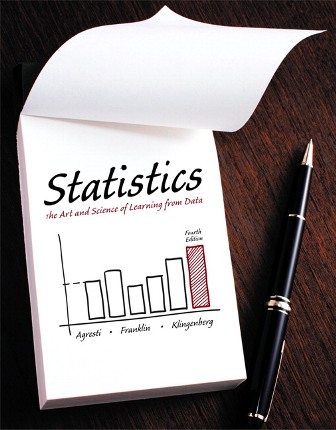Test Bank for Statistics: The Art and Science of Learning from Data, 4th Edition, Alan Agresti, ISBN-10: 0321997832, ISBN-13: 9780321997838
$35.00
Test Bank for Statistics: The Art and Science of Learning from Data, 4th Edition, Alan Agresti, ISBN-10: 0321997832, ISBN-13: 9780321997838
Test Bank for Statistics: The Art and Science of Learning from Data, 4th Edition, Alan Agresti, ISBN-10: 0321997832, ISBN-13: 9780321997838
ISBN-10: 0134101677 • ISBN-13: 9780134101675
Table of Contents
PART ONE: GATHERING AND EXPLORING DATA
1. Statistics: The Art and Science of Learning from Data
1.1 Using Data to Answer Statistical Questions
1.2 Sample Versus Population
1.3 Using Calculators and Computers
Chapter Summary
Chapter Problems
2. Exploring Data with Graphs and Numerical Summaries
2.1 Different Types of Data
2.2 Graphical Summaries of Data
2.3 Measuring the Center of Quantitative Data
2.4 Measuring the Variability of Quantitative Data
2.5 Using Measures of Position to Describe Variability
2.6 Recognizing and Avoiding Misuses of Graphical Summaries
Chapter Summary
Chapter Problems
3. Association: Contingency, Correlation, and Regression
3.1 The Association Between Two Categorical Variables
3.2 The Association Between Two Quantitative Variables
3.3 Predicting the Outcome of a Variable
3.4 Cautions in Analyzing Associations
Chapter Summary
Chapter Problems
4. Gathering Data
4.1 Experimental and Observational Studies
4.2 Good and Poor Ways to Sample
4.3 Good and Poor Ways to Experiment
4.4 Other Ways to Conduct Experimental and Nonexperimental Studies
Chapter Summary
Chapter Problems
Part Review 1 (ONLINE)
PART TWO: PROBABILITY, PROBABILITY DISTRIBUTIONS, AND SAMPLING DISTRIBUTIONS
5. Probability in Our Daily Lives
5.1 How Probability Quantifies Randomness
5.2 Finding Probabilities
5.3 Conditional Probability
5.4 Applying the Probability Rules
Chapter Summary
Chapter Problems
6. Probability Distributions
6.1 Summarizing Possible Outcomes and Their Probabilities
6.2 Probabilities for Bell-Shaped Distributions
6.3 Probabilities When Each Observation Has Two Possible Outcomes
Chapter Summary
Chapter Problems
7. Sampling Distributions
7.1 How Sample Proportions Vary Around the Population Proportion
7.2 How Sample Means Vary Around the Population Mean
Chapter Summary
Chapter Problems
Part Review 2 (ONLINE)
PART THREE: INFERENTIAL STATISTICS
8. Statistical Inference: Confidence Intervals
8.1 Point and Interval Estimates of Population Parameters
8.2 Constructing a Confidence Interval to Estimate a Population Proportion
8.3 Constructing a Confidence Interval to Estimate a Population Mean
8.4 Choosing the Sample Size for a Study
8.5 Using Computers to Make New Estimation Methods Possible
Chapter Summary
Chapter Problems
9. Statistical Inference: Significance Tests About Hypotheses
9.1 Steps for Performing a Significance Test
9.2 Significance Tests About Proportions
9.3 Significance Tests About Means
9.4 Decisions and Types of Errors in Significance Tests
9.5 Limitations of Significance Tests
9.6 The Likelihood of a Type II Error
Chapter Summary
Chapter Problems
10. Comparing Two Groups
10.1 Categorical Response: Comparing Two Proportions
10.2 Quantitative Response: Comparing Two Means
10.3 Other Ways of Comparing Means and Comparing Proportions
10.4 Analyzing Dependent Samples
10.5 Adjusting for the Effects of Other Variables
Chapter Summary
Chapter Problems
Part Review 3 (ONLINE)
PART FOUR: ANALYZING ASSOCIATION AND EXTENDED STATISTICAL METHODS
11. Analyzing the Association Between Categorical Variables
11.1 Independence and Dependence (Association)
11.2 Testing Categorical Variables for Independence
11.3 Determining the Strength of the Association
11.4 Using Residuals to Reveal the Pattern of Association
11.5 Fisher’s Exact and Permutation Tests
Chapter Summary
Chapter Problems
12. Analyzing the Association Between Quantitative Variables: Regression Analysis
12.1 Modeling How Two Variables Are Related
12.2 Inference About Model Parameters and the Association
12.3 Describing the Strength of Association
12.4 How the Data Vary Around the Regression Line
12.5 Exponential Regression: A Model for Nonlinearity
Chapter Summary
Chapter Problems
13. Multiple Regression
13.1 Using Several Variables to Predict a Response
13.2 Extending the Correlation and R2 for Multiple Regression
13.3 Using Multiple Regression to Make Inferences
13.4 Checking a Regression Model Using Residual Plots
13.5 Regression and Categorical Predictors
13.6 Modeling a Categorical Response
Chapter Summary
Chapter Problems
14. Comparing Groups: Analysis of Variance Methods
14.1 One-Way ANOVA: Comparing Several Means
14.2 Estimating Differences in Groups for a Single Factor
14.3 Two-Way ANOVA
Chapter Summary
Chapter Problems
15. Nonparametric Statistics
15.1 Compare Two Groups by Ranking
15.2 Nonparametric Methods for Several Groups and for Matched Pairs
Chapter Summary
Chapter Problems
Part Review 4 (ONLINE)
Tables
Answers
Index
Index of Applications
Photo Credits












Reviews
There are no reviews yet.